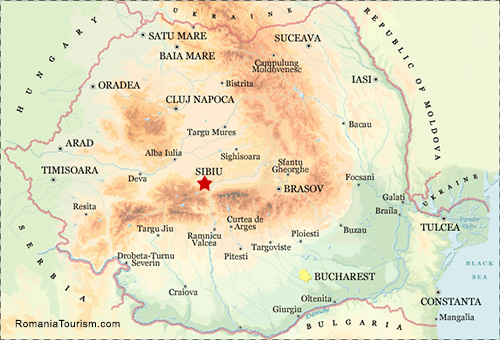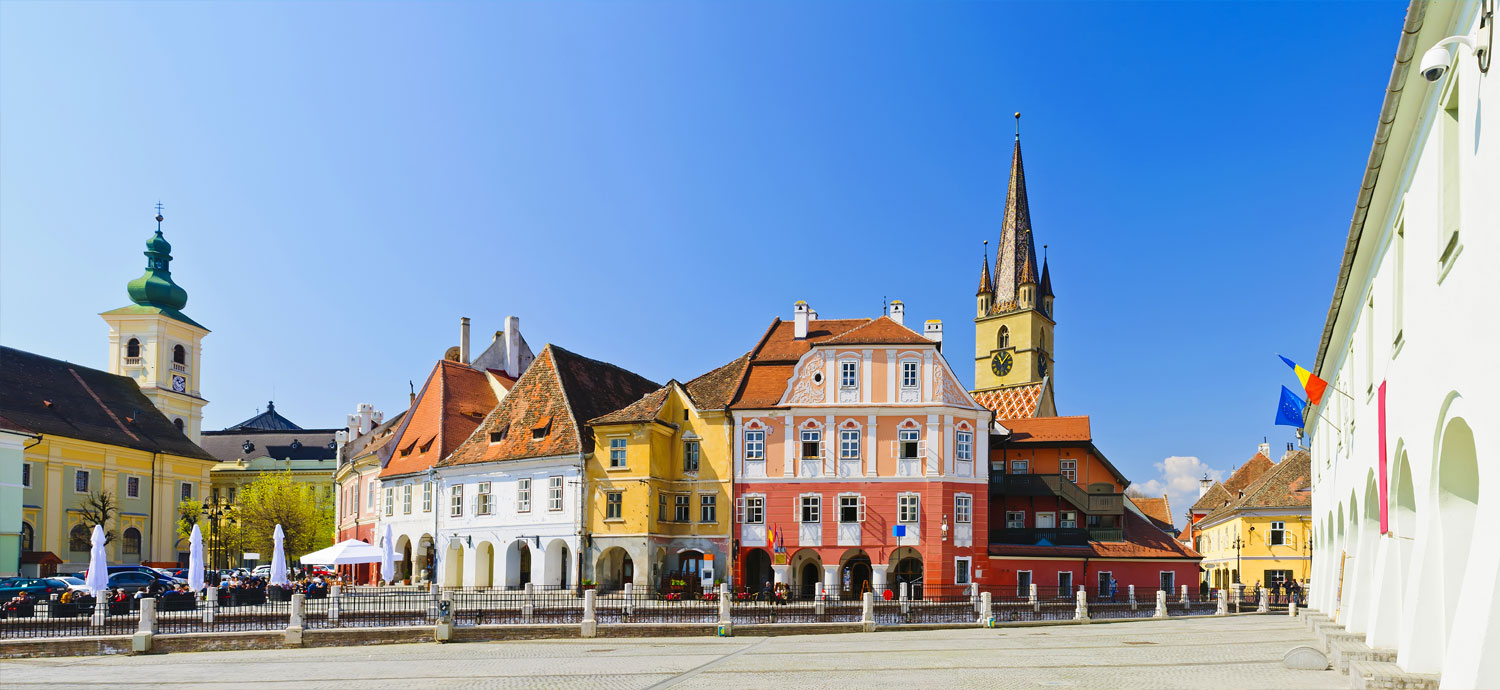
Name: Sibiu (pronounced See beeu)
Location: Southern Transylvania
Nearest airport: Sibiu (SBZ)
Area: 46.7 sq. miles (121 sq. kilometers)
Elevation: 1,410 ft. (430 meters)
Population: 134,000
First documented: 1191 AD
Oldest building in town: Casa Böbel (1370)
Sibiu Sights and Landmarks
Sibiu (Hermannstadt in German) was the largest and wealthiest of the seven walled citadels (Siebenburgen)
founded in the 12th century by German settlers known as 'Transylvanian Saxons'.
The riches amassed by its guilds paid for the construction of both impressive buildings and the fortifications required to protect them.
Sibiu Old Town retains the grandeur of its earlier days when rich and powerful guilds dominated regional trade.
Like Sighisoara and Brasov - two other outstanding towns in southern Transylvania - it has a distinctly Germanic feeling.
Sections of the medieval wall still guard the historic area,
where narrow streets pass steep-roofed 17th century buildings with gable overhangs before opening into vast,
church-dominated squares such as Great Square and Little Square.
Pedestrian-friendly, Sibiu Old Town has two distinct sections:
the Upper Town, home to most of Sibiu's historic landmarks, and the Lower Town,
lined with colorful houses on cobblestone streets and bounded by imposing city walls and defense towers overlooking the river Cibin.
Sibiu is home to the first hospital in Romania (1292), the first pharmacy (1494)
and the oldest museum in Romania, the Brukenthal Museum, opened in 1817
The first book in the Romanian language was printed in Sibiu in 1544.
Traditionally, the Upper-Town was wealthier and concentrated businessmen and tradesmen; the Lower-Town served as the manufacturing area. Most popular attractions in Sibiu Old Town include the Great Square, Huet Square, the beautiful Passage of Steps (which connects the upper town to the lower town), Goldsmiths' Square, the Smaller Square as well as the Bridge of Lies.
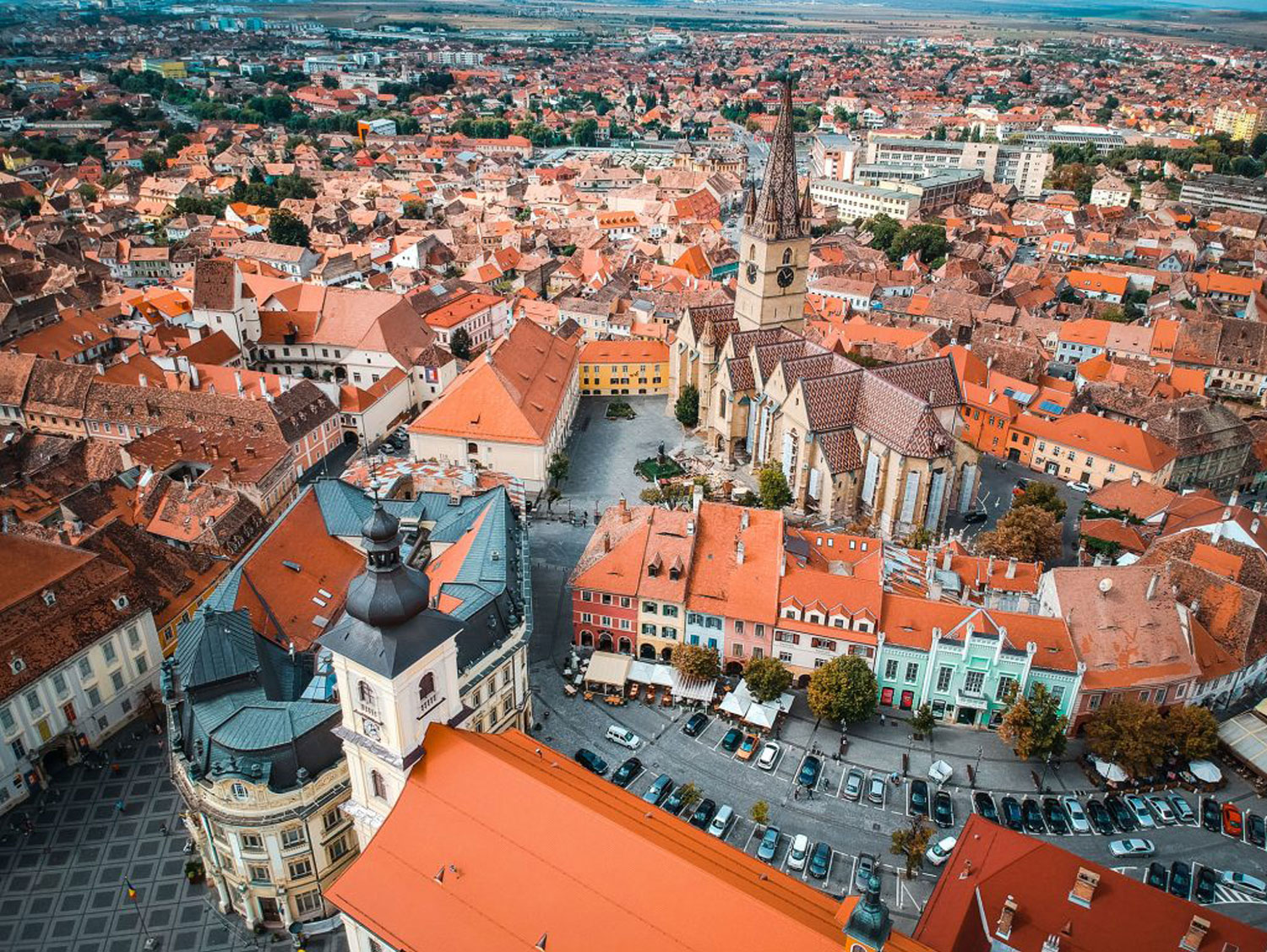
Turnurile Sibiului
For hundreds of years, this walled town in the heart of Transylvania was one of the most powerful and prosperous strongholds in Eastern Europe.
Surrounded by imposing walls, Sibiu Old Town limits are marked by the original fortifications which included 39 defensive towers,
five bulwarks, four gates and five artillery batteries.
Although the entire network is remarkably well-preserved, the best-maintained section is the southeastern side
which has been reinforced several times throughout the centuries since attacks most often came from that direction.
Three 15th century towers have withstood the test of time: Harquebusiers' Tower (Turnul Archebuzierilor),
Carpenters' Tower (Turnul Dulgherilor) and Potters' Tower (Turnul Olarilor).
The 16th century The Thick Tower (Turnul Gros) was the site of Sibiu's first theatrical performance, staged in 1778.
Orașul de Sus
At the centre of the upper town there are three beautiful squares.
The Great Square - a large, open, space where most community events and Sibiu Christmas Market are held.
The Roman-Catholic church and Brukenthal Palace, home to one of Romania's most important art collections, are two of the structures facing the Great Square.
A passage beneath the Old Town Council Tower connects the Great Square with the equally beautiful Little Square.
The third square of Sibiu, Huet Square, is dominated by the Evangelical Cathedral.
Piața Mare
First mentioned in a written document in 1411 as a grain market, |
the Great Square – the largest in the city - has been throughout the centuries a quiet witness
to the town's lively merchant activity, assemblies and even public executions.
Located in the heart of the old walled city, the square was designated an architectural monument by UNESCO
and features some of the most impressive buildings in Sibiu.
Best viewpoint of Sibiu Old Town
For an outstanding panorama of Sibiu Old Town climb to the top of the Evangelic Church Tower
Admission 5 Lei ($1.25 US).
Biserica Romano-Catolica
Address: Piata Mare
The north side of the Great Square is dominated by the Roman-Catholic Church (Biserica Romano-Catolica).
This beautiful baroque structure with classical decorations was built between 1726 and 1738.
The tower was attached to the nave in 1738 and one year later, a cross was seated on the top.
The completely renovated interior is magnificent with gold-laced walls and colorful ceiling frescoes.
Intricate stone carvings cover much of the nave while the side altars and colonnades glisten with pink marble.
The fresco behind the altar was painted in 1777 by Anton Steinwald. Inside the church is the stone grave of Otto Ferdinand de Abensberg,
commander of Transylvania between 1744-1747. Organ recitals are usually held once a week.
Turnul Sfatului
Address: Piața Mare
At the corner with Avram Iancu Street stand the old mayor's residence and the imposing Council Tower (Turnul Sfatului).
Built in the 13th century, this tower guarded the gate to the second row of fortified walls, built around Sibiu.
Throughout the centuries, the Council Tower served as a grain storehouse, a fire watchtower,
a temporary prison and even as a museum of botany. The roof, originally built in pyramid form,
has undergone various changes, culminating in the addition of four corner turrets in 1826.
On the top floor, an observation deck allows a bird's-eye view of Sibiu Old Town and the Fagaras Mountains beyond.
Palatul Brukental
Address: Piata Mare 4 - 5
Facing west of the square is the stunning Brukenthal Palace (Palatul Brukental),
built between 1778-1785 by a Viennese architect in a refined late-baroque style.
It is now the home of the Brukenthal Museum (Muzeul Brukenthal), the oldest and one of the finest art museums in the country.
The palace was built by Baron Samuel von Brukenthal to serve as his residence
and house his collections of Romanian and Western art, 16th – 18th century religious sculptures and icons,
stamps and coins, as well as an impressive library.
Over the years, the collections have been enriched through acquisitions and donations.
Even though the museum officially opened in 1817, its art galleries welcomed visitors 27 years earlier (1790), three years prior to the opening of the Louvre in Paris - France.
Completing the picture is the fairy-tale Blue House, an 18th century baroque house bearing the old coat of arms of Sibiu on its facade.
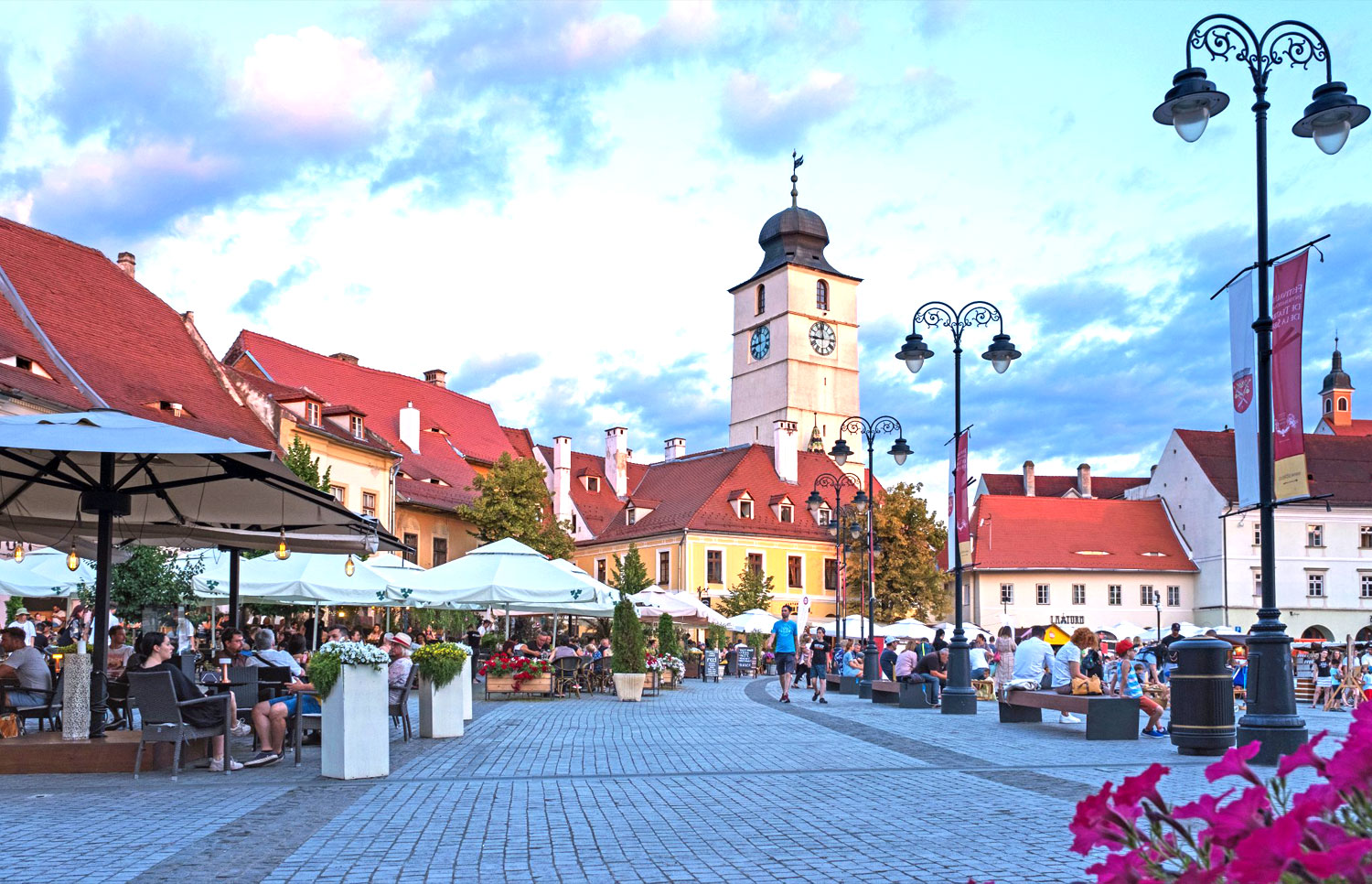
Piața Mică
From the Great Square, walk through one of two tunnels under the arches of the Council Tower to arrive at the Little Square.
This second fortified square was home to the town's most prestigious master craftsmen, |
who lived in rows of arcaded houses along the north and east sides.
Today, small shops, cafes and businesses line the square.
Piața Huet
Huet Square is home to a mix of gothic buildings dominated by the Evangelical Cathedral (Biserica Evangelica).
This impressive structure, featuring five pointed towers, was built in 1520 on the site of an old Roman basilica.
The simple, stark interior is in total contrast to that of the Catholic Church.
A gigantic fresco, painted by Johannes of Rosenau in 1445, covers much of the chancel's north wall.
The mural shows the Crucifixion and marks a transition in painting from late-gothic style to renaissance style.
On the south side, the choir loft boasts a beautiful fan-vaulted ceiling, home to a baroque organ designed by a German master in 1671.
Six thousand pipes were installed in 1914, making it the largest organ in Romania.
Here, you can also find the city's only German school, the Samuel von Brukenthal Gymnasium, which exemplifies the city's proud German heritage.
The first 'commercial' brewery in Romania opened in Sibiu in 1717. It was located on Strada Turnului nr. 19.
Orașul de Jos
The Lower-Town comprises the area between the river and the hill, and it developed around the earliest fortifications.
The streets are long and quite wide for medieval city standards, with small city squares at places.
The architecture is rather rustic: typically two-storey houses with tall roofs and gates opening passages to inner courts.
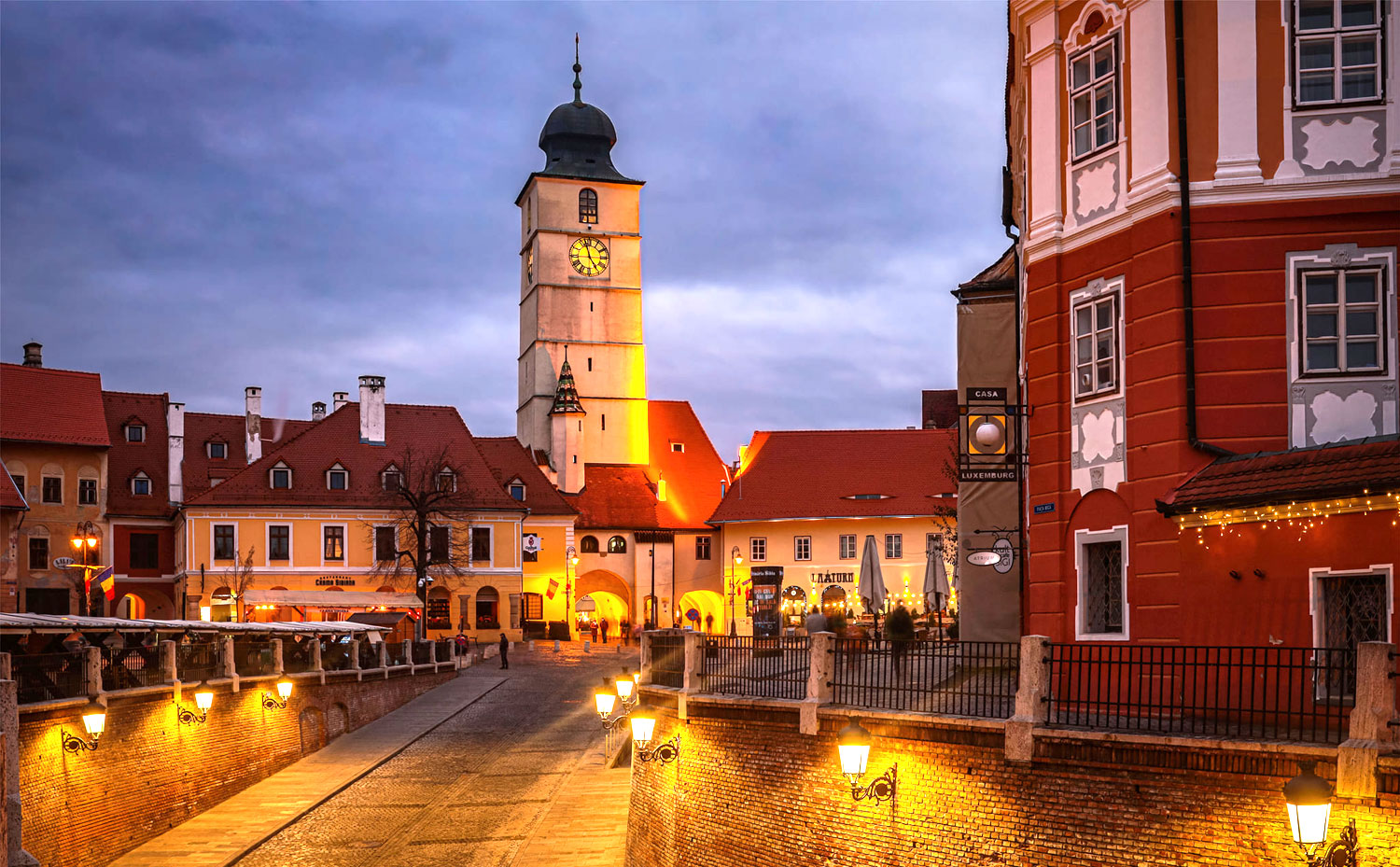
Podul Minciunilor
Several steep streets and stairways lead from the Lower to the Upper Town and,
one of them passes beneath the "Bridge of Lies" - a popular meeting place among the locals.
Built in 1859 by Fredericus Hutte, this was the first cast iron bridge in Romania.
There are several legends concerning the name of the Bridge of Lies in Sibiu.
One involves merchants who were discussing business on the bridge and trying to swindle their clients.
Another is that the bridge will collapse as soon as anyone tells a lie, while on it.
The bridge, a favorite meeting point for young lovers, 'heard' too many passionate but transitory vows.
Despite all the legends, the current name of the bridge is due to a translation error:
The bridge was initially called Liegenbrücke, German for lying bridge (built without supporting pillars),
which sounds very similar to Lügenbrücke, meaning "bridge of lies".

Pasajul Scarilor
The 13th century Passage of Steps, an architectural masterpiece with twin staircases and archways, connects the Upper Town to the Lower Town.
Built in the 13th century, it is one of the most picturesque places in Sibiu.
At one end of the passage stands the city's oldest building which now hosts the oldest restaurant in Romania,
The Golden Barrel (Butoiul de Aur).

Piața Aurarilor
The Goldsmiths' Square, a peaceful and intimate square, is surrounded by charming old houses with medieval windows, doorways and turrets.
For many years, it was the main point of passage between the Little Square and the Lower Town, the two connected by a 15th century stairway.
Bastionul Haller
Address: Str. Spitalelor
Located at the north end of Onofreiu Square (Piata Onofreiu), the bastion is named after Sibiu's 16th century mayor,
Petrus Haller, who had the red-brick tower built in 1551.
Catedrala Ortodoxa Mitropolitana Sfanta Treime
Address: Str. Mitropoliei 35
Constructed between 1902–1906 on the site of a former Greek church, it shares a similar style with Saint Sofia Cathedral in Istanbul, Turkey. The interior is dominated by a massive gold chandelier and features neo-Byzantine decorations. This is the second largest Orthodox cathedral in Romania (the biggest one is located in Iasi).
Manastirea Ursulinelor
Address: Str. General Gh. Magheru 34 - 36
In 1474 a Dominican Monastery was built on the site.
69 years later (1543) the Lutherans took over following a major religious reform that led to the conversion of a large part of the Saxon population to the Lutheran religion.
In 1728, the Ottoman influence in Transylvania ends and Habsburg administration begins.
The church reverted to the Roman-Catholic cult and the complex of buildings, of the former Dominican monastery,
was assigned to a group of Ursuline nuns that came from Pojon (Slovakia).
Between 1728 and 1733, the Ursuline nuns rebuilt the church in Baroque style;
a few buttresses and the Gothic entrance, of the old church, have survived.
(The Ursuline Order was a religious order founded in the 16th century in the context of the Counter-Reformation
and named after St. Ursula, a Christian martyr who is celebrated annually on October 21.
The Ursuline nuns campaigned to support the education of the young, the elderly, the sick and the needy.)
Also known under the German name of Klosterkirche, the building still features many of its former gothic details,
including the portal and the piles. Inside, the church has three altars and
beautiful paintings and statues representing various saints and protectors of the church.
Just above the main portal of the Church there is the statue of St. Ursula, dressed in a white dress,
with a cloak bearing the symbol of the cross. In her right hand she holds palm leaves - symbols of martyrdom.
A double-headed eagle, the symbol of the Habsburg monarchy, is embossedOn the main arch.
The monogram of Maria Theresa (archduchess of Austria and queen of Hungary and Bohemias) is also depicted on the main arch
to recognize her support for the restoration of the Ursulines' Church.
They are about 300 years old and still exist in the old (15th century) Dominican tunnels.
Each tomb has a corresponding number, painted above it;
it helps find information and documents about the deceased in the parish archives.
The catacombs are open to visitors, appointment needed.
Biserica din Groapa
Address: Str. Justitiei 5
This small Orthodox Church, built in 1789,
features beautiful interior frescoes and a tower in three levels.
Although documents attest the existence of Jews in Sibiu since the 12th century, the Jewish community of Sibiu was never among the biggest in Romania. In 1940 the town had some 1,300 Jews, three synagogues, three rabbis, two cemeteries and two ritual baths managed by the Sephardic and Orthodox communities. Today, the handful of Jews who remain in Sibiu hold weekly and holiday services at the Great Synagogue.
The Great SynagogueAddress: Str. Constitutiei 19
Built after plans by architect Szalay Ferenc in 1899, with funds collected by Sibiu's small Jewish community,
this synagogue boasts a neo-gothic façade. The inside has a basilica-like shape with three naves mounted by lofts.
Book your 'tips-based' Sibiu Walking Tour.
Tips-based tours do not have a set ‘price’ and no upfront payment is required.
At the end of the tour each participant gives the guide the amount that she/he considers appropriate.
Sibiu - a video introduction
"... a perfectly preserved medieval village
where towering Gothic steeples pierce the skyline, and winding, colorful alleys lead to sprawling, sunlit squares."
(Zachary Allen Murphy, photographer, video content creator, explorer.)
...
Sibiu Museums
Brukenthal Museum of ArtMuzeul Brukenthal
Address: Piața Mare 4 - 5
Telephone: (+4) 0269 217.691
Hours
and Admission
Sibiu is home to Transylvania's finest art museum, the Bruckenthal.
Founded in 1790 by Samuel Brukenthal, the governor of Transylvania, the museum opened to the public in 1817.
Brukenthal is the oldest museum in Romania and one of the first museums to be founded in Europe.
The art collection includes paintings by Rubens, Van Dyck and Teniers, as well as works of German, Austrian and Romanian masters.
Additionally, it features a 16th century silverware collection, painted glass icons and 350 rare books,
many dating to the days of the first printing press.
Among them are books that belonged to Sibiu's first library, founded in 1299.
A comprehensive index of Brukenthal Museum books collection is available at Brukenthal Library Website.
Muzeul in aer liber ASTRA -Dumbrava Sibiului
Address: Strada Pădurea Dumbrava 16
(2 miles south of downtown Sibiu)
Bus # 13 connects Sibiu train station with ASTRA Museum.
Telephone: (+4) 0269 242.419
Opening Hours and
Admission
Located in the middle of a dense forest and surrounded by a beautiful lake,
ASTRA features more than 300 original buildings as well as watermills, windmills, gigantic fruit and seed presses
hydraulic forges and structures representing village architectural styles from many parts of Romania.
The museum illustrates the technological legacy of the Romanian people.
There is a wonderful collection of wooden farmhouses, a cherhana (a traditional fish collecting and storage point)
and sheepfolds, as well as a wooden church and two traditional inns.
Guided tours are available. Another option is a visit by horse-drawn carriages
(driver will kiss ladies' hand, in greeting, an old Romanian custom).
Muzeul de Istorie
Address: Str. Mitropoliei 2
Tel: (+4) 0269 218.143
Open: Tuesday -- Sunday: 9 a.m. – 5 p.m. (wintertime 10 a.m. – 6 p.m.)
Admission charge
Sibiu History Museum is housed in the Old Town Hall (Primaria Veche), which dates to 1470
and boasts typical Transylvanian gothic civil architecture.
Information and objects which illustrate the long and rich history of Sibiu and the region,
from Neolithic and Roman times to the present, are presented. An unique collection of fine silverware is also on display.
Muzeul de Istorie Naturala
Address: Str. Cetății 1
Tel: (+4) 0269 213.156
Open: Tue. – Sun. 10 a.m. – 6 p.m.
Admission charge
One of the oldest and richest of its kind in Romania, this museum was founded by the Transylvanian Association of Natural Science
(Siebenburgischer Verein für Naturwiessenschaften in German) in 1849.
An astronomic observation centre also is located here.
Muzeul de Etnographie si Arta Populara Saseasca "Emil Sigerus"
Address: Piata Mica 12
Tel: (+4) 0269 218.195
Open: Tue. – Sun. 9 a.m. - 6 p.m.
(wintertime 10 a.m. – 5 p.m.);
Admission Charge
Collections of painted furniture, costumes-textiles-embroideries and pottery, initiated by Emil Sigerus,
the most important collector of Transylvanian Saxon Folk Art at the end of the 19th century.
Emil Sigerus museum also includes the original collections of the Transylvanian Carpathians Museum
or MSVK opened in 1895 by the Siebenbugishen Karpathenverein Association.
Muzeul de Arme si Trofee de Vanatoare
Address: Str. Scoala de Inot 4
Tel: (+4) 0269 217.873
Open: Tue. – Sun. 9 a.m. – 5 p.m. (wintertime 9 a.m. – 4 p.m.);
Admission charge
Founded in 1966, the museum features a collection of weapons, medals and stuffed animals.
Some of the exhibits are over 100 years old, such as the hunting trophies brought after a long safari in Africa
by Colonel Spiess, who was a Master of Hunting of the Royal House of Romania.
Muzeul de Etnografie Universala Franz Binder
Address: Piata Mica 11
Tel: (+4) 0269 218.195
Open: Tue. – Sun. 10 a.m. – 6 p.m.
The Franz Binder collections, housed in the "Hermes House" (initially called "The House of the Small Handicraftsmen's Association")
built between 1865 and 1867, were established in the 19th century through donations and acquisitions from travelers and collectors.
The permanent exhibition, "From the art and culture of the world – the people of the world,"
displays objects from various parts of the world, including northern Africa and
the springs of the Nile, China, Japan, Oceania, Asia Minor, Brazil, Lapland and Australia.
Muzeul de Istorie a Farmaciei
Address: Piata Mica 26
Tel: (+4) 0269 218.191
Open: Tue. – Sun. 10 a.m. – 6 p.m.
Admission charge
Housed in a 16th century building where the oldest pharmacy in Romania, La Ursul Negru (The Black Bear),
operated for over 150 years, this museum showcases some 6,000 pieces of medical equipment from the 16th to the 19th centuries,
coming from chemist shops and hospitals. Sibiu had more chemists than any other town in Transylvania.
The collections of the museum cover the whole range of medical instruments,
from surgical pouches, microscopes, different bowls made of wood, china, glass, bronze mortars, stands with balances and weights
in the Viennese style to the oldest piece of the collection, a 1597 bronze mortar used for preparing medicines.
At the front, a reconstructed shop is decked out with wooden Viennese counters
and stacks of glass jars creating the atmosphere of an 18th century "apoteka" (German for "pharmacy").
Muzeul Locomotivelor cu Aburi
Address: Str. Dorobantilor 22
Tel: (+4) 0269 431.685
Admission charge
Sibiu Steam Engine Museum displays 23 standard gauge steam engines, 10 narrow gauge steam engines,
three snowplows and two steam cranes. The steam engines were built between 1885 and 1959 in Romania
(at Resita and Malaxa Factories in Resita respectively Bucharest), Germany (Henschel, Borsig, Schwartzkopff) and USA (Baldwin).
The museum is located accross the street from Sibiu train station.
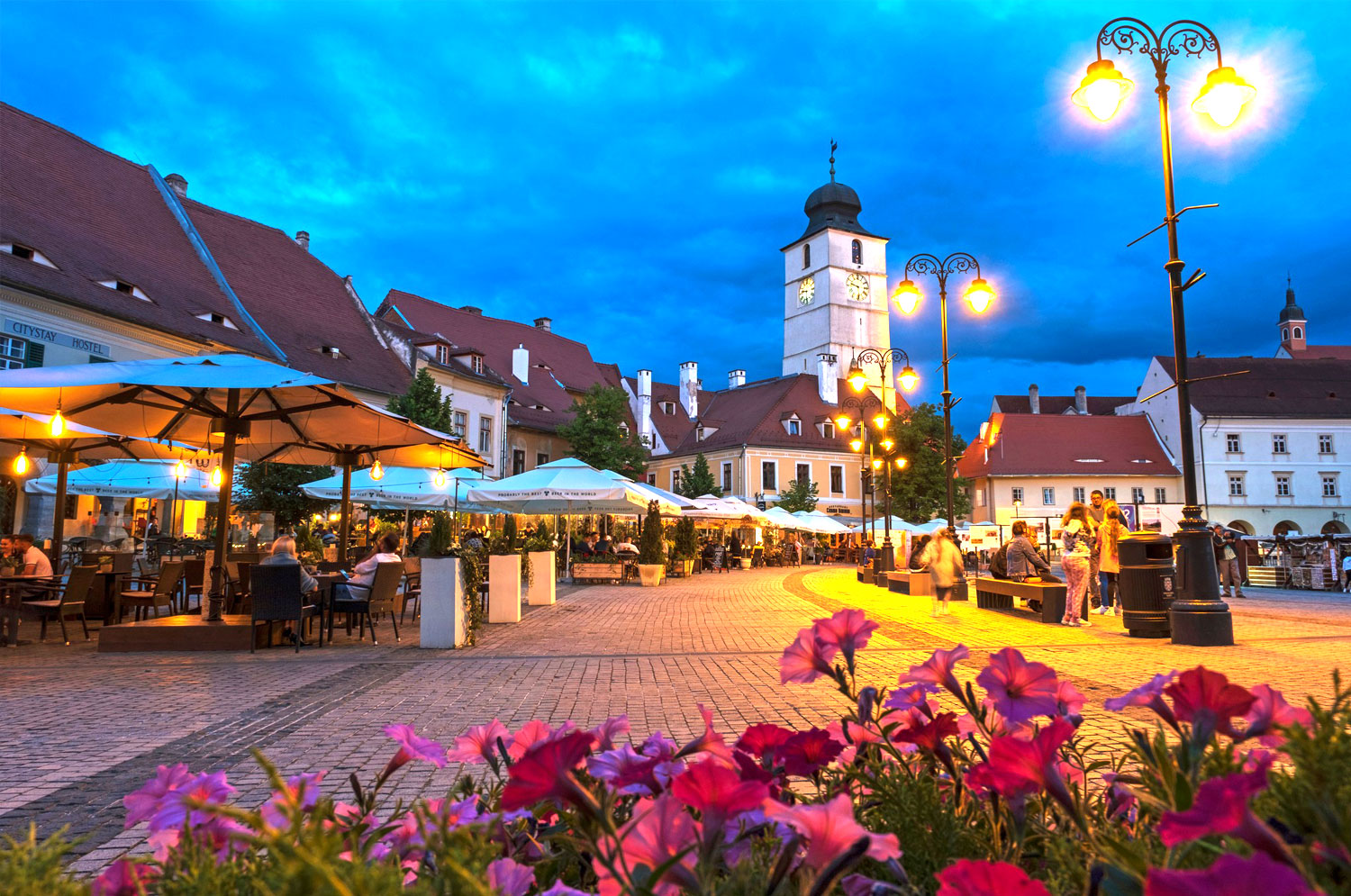
...
Sibiu Performing Arts
Symphonic MusicSibiu State Philharmonic
Filarmonica de Stat Sibiu
Address: Str. Cetatii 3-5
Tel. (+4) 0269 210.264
Weekly classical music concerts take place in Thalia Hall, a concert hall dating from 1787.
Radu Stanca National Theatre
Teatrul National "Radu Stanca"
Address: Bd. C. Coposu 2
Tel: (+4) 0269 210.092
Radu Stance is one of the Romania's leading theatres, with origins dating back to 1787.
Both Romanian-language and German-language productions are presented (five shows a week, average).
Gong Theatre
Teatrul Gong
Address: Str. Alexandru Odobescu 4
Tel: (+4) 0269 211.349
Specializing in puppetry, mime and non-conventional shows for children and teenagers,
Gong theatre offers performances in both Romanian and German.
...
Attractions not far from Sibiu
Sibiu makes an ideal base for the exploration of the nearby countryside and villages which display an interesting mixture of Saxon and Romanian traditions.
Mărginimea SibiuluiLocated at the foothills of the Cindrel Mountains, a half-hour drive from Sibiu,
Marginimea Sibiului region is considered one of Transylvania's best-preserved ethnographic areas.
Marginimea Sibiului (translation: Sibiu Outskirts / Beyond the City Limits),
encompasses a string of 18 villages*, rich in architecture, history and heritage.
Age-old traditions, customs and celebrations, as well as the traditional occupation of sheepherding,
have been carefully passed down from generation to generation in the villages of this area.
* The 18 villages are: Boita, Sadu, Raul Sadului, Talmaciu, Talmacel. Rasinari, Poplaca, Gura Raului,
Orlat, Fantanele, Sibiel, Vale, Saliste, Gales, Tilisca, Rod, Poiana Sibiului and Jina.
Mărginimea Sibiului is easily accessible by train or bus. Trains from Sibiu to town of Sebes stop at Sibiel (25 minutes), Saliste (35 minutes) and Miercurea Sibiului (1hour and 15 minutes).
Village Rășinari, first documented in 1204, is the oldest in the region, followed by Talmaciu (1318), Orlat (1322) and Saliste (1354). Village Saliste claims the oldest church, housing beautiful interior frescoes (1674); Poiana Sibiului wooden church was built in 1771.
Village RășinariOne of the wealthiest villages in the region, Rășinari, is famed for its local carpentry and sheep farming.
The village has an interesting Ethnography Museum
(open Tue. – Sun. 10 a.m. – 5 p.m.) and a painted Orthodox church built in 1752.
The annual Pastoral Folklore Festival takes place on the third Sunday of April.
Rășinari is connected to Sibiu by a roughly 4-mile tramline that crosses Dumbrava Forest.
Trams to Rășinari run every 30 mins. at peak times (7 a.m. – 9 a.m. and 1 p.m. – 3 p.m.) and every hour for the rest of the day.

Muzeul de Icoane pe Sticla "Preot Zosim Oancea"
Address: Str. Bisericii 329, Sibiel
Telephone: (+4) 0771 441 839
Painting on glass has been a tradition for 200 years in Marginimea Sibiului villages.
In 1968, the founder of the museum, priest Zosim Oancea, started to collect 18th and 19th century icons richly painted on glass.
Today, the museum exhibits the largest collection of painted glass icons in Europe - more than 700, as well as old, traditional, furniture and ceramics.

Biserica Fortificată Cristian
Where: 5 miles west of Sibiu
Cristian Fortified Church info
Where: 6 miles south of Sibiu
How to get here: bus or car
Cisnădie (German: Heltau) was mentioned for the first time in a document from the year 1204 under the name "Rivetel."
In the 12th century Saxon colonists settled here and in 1323, the German name Heltau is mentioned.
During the centuries, the town flourished, particularly the guilds of sicklesmiths and wool weavers.
Weaving remained the traditional occupation of the townspeople until the 20th century, when large textile factories were built.
The Textile Museum (Expozitia Muzeala "Istoricul Industriei Textile") has a comprehensive coverage of this local industry.
The museum, located at Str. Apararii 2 is open Mon. – Sat. 8 a.m. to 4 p.m.
The most important architectural site is the Cisnadie Fortified Church located in the town centre.
A climb to the belfry offers a super view of Cisnadie's red rooftops and courtyards, while in the distance,
nestled at the foot of the Cindrel Mountains, you can catch a glimpse of Cisnadiaora.
Where: village Cisnadioara, 2 miles west of Cisnădie and 8 miles south of Sibiu
Cisnădioara (German: Michelsberg) is home to a historic Romanesque church dating from 1223 and a hilltop citadel,
which frequently withstood Tatar attacks.
Locals often took cover in the citadel, which they defended by hurtling down rocks which had been carried to the top of the hill by aspiring husbands.
Local lore says that no young man was marriage-worthy until he had carried a heavy rock from the riverbed up the steep track.
In the centre of Cisnadioara stands an old baroque church and a small museum that exhibits
beautiful collection of artifacts and tools from Saxon households.
Where: Cornatel - 12 miles east of Sibiu
Hosman -- Cornatel narrow-gauge railway info
Where: 12 miles south west of Sibiu
How to get to Păltiniș: car or Bus #22 from Sibiu railway station (Gara)
Founded in 1894 by the Transylvanian Carpathian Society (S.K.V.),
Păltiniș (German: Hohe Rinne) is Romania's ski town located at the highest altitude (4,724 ft. / 1,440 m).
During the summer, Păltiniș attracts visitors with its beautiful scenery, fresh air and numerous hiking and mountain biking trails.
Other attractions near Sibiu:
Electricity Museum "Sigmund Dachler" - Sadu.
(Muzeul Electro-Energeticii Sibiene "Sigmund Dachler")
In 1896, the first hydropower plant in Romania and the third in Europe was opened near town of Sadu, 12 miles south of Sibiu.
the plant is still in function today and generates electricity for the town of Sadu and nearby villages.
Named after the first director of the plant, one of the pioneers of electricity in Romania, this small museum
documents the beginning of generation of electricity in Transylvania and exhibits original electric equipment, documents and old photos.
Orlat Fortress (1317)
Săliște Culture Museum in Săliște
Dacian Fortress near village Tilișca
Dobarca Fortified Church (13th century)
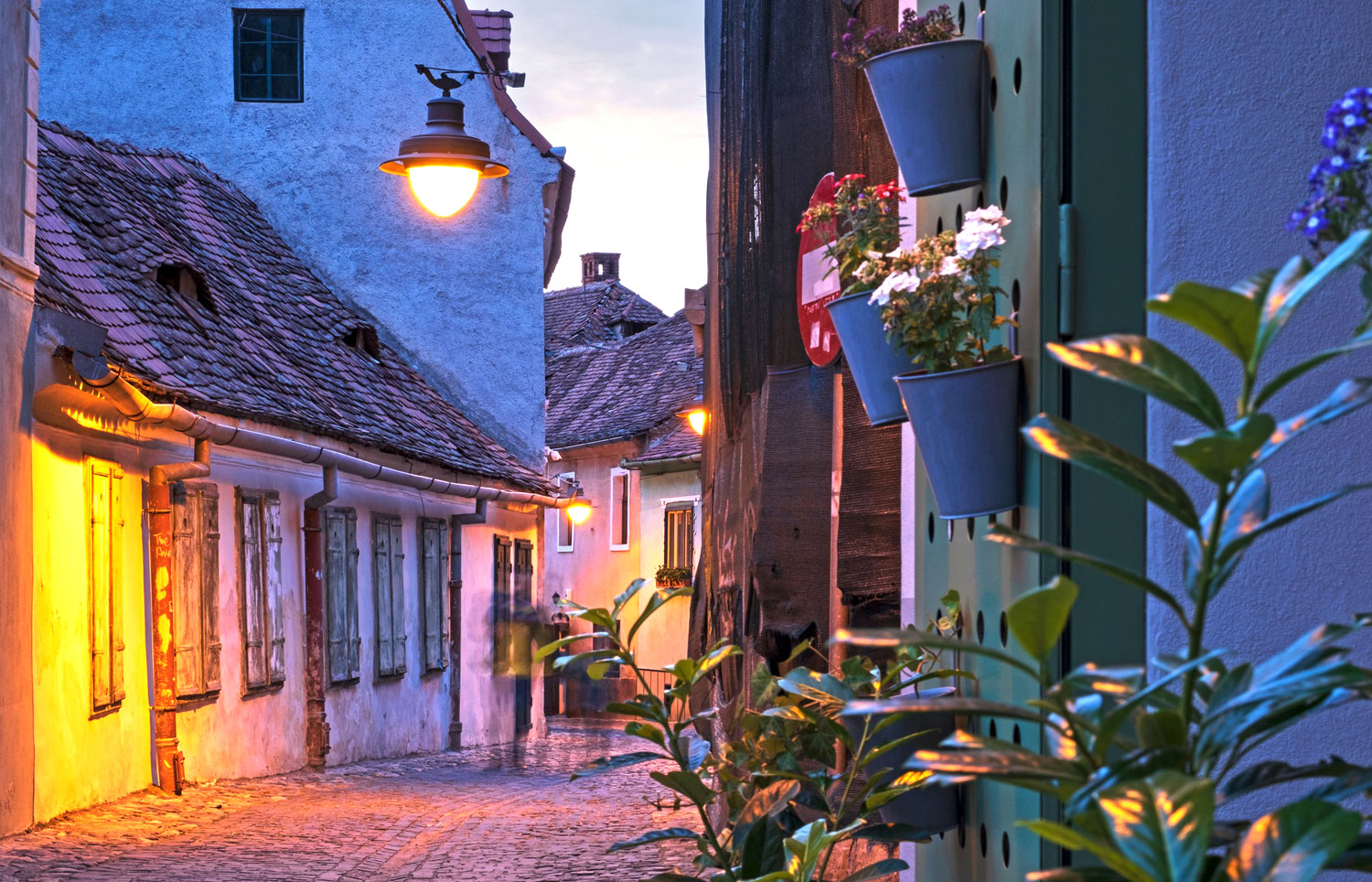
...
Day Trips from Sibiu
TransFăgărășan Scenic Road (DN7C)Where: 25 miles southeast of Sibiu
How to get here: car, tour bus
The TransFagărășan is open - weather permitting - July 1 or late June until October 31).
This winding road that climbs to 6,700 ft. above the sea level features long S-curves, steep ramps and descents
and offers breath-taking views around every one of its many twists and turns.
DN7C (national road 7C), also called Transfăgărășan, begins 25 miles east of Sibiu,
when it branches south, off the road Sibiu to Brasov and
heads to town of Pitesti, crossing the towering Făgăraș Mountain range.
This two-lane road connects two historic regions of Romania: Transylvania and Walachia.
over 13 million pounds (6 million kilos) of dynamite were used to blast through the rocks on the north side - that's 625 train wagons.
The TransFagarasan has more tunnels and viaducts than any other road in Romania. In the vicinity of the highest point, at Lake Balea (Balea Lac), the road passes through Romania's longest road tunnel (about 2880 ft; 900 m), the only road connection over Fagaras mountains range. The difference between the north and south sides of Fagaras mountains is apparent. While on the northern side the landscape is barren and alpine as the road makes its way up an amazing glacial valley, on the southern side the road drops gradually through pleasant green scenery. Visitors continuing to town of Pitesti can stop and visit the spectacular Vidraru Lake & Dam, the (real) Dracula Castle ruins in village Poienari and the stunning Curtea de Arges, 16th century, monastery.
Outstanding beautiful Orthodox architecture: Monasteries Curtea de Arges and HureziWhere: Town of Curtea de Arges - 85 miles south of Sibiu
Hurezi/ Horezu: 92 miles south of Sibiu (or 135 miles via Curtea de Arges)
How to get there: car
Travel from Sibiu to Curtea de Arges, along Olt River valley to Curtea de Arges (optional stop Cozia Monastery),
to visit the early 14th century Princely Court and the Princely Church home to unique 14th century interior frescoes.
Next recommended visit is the stunning, 16th century, Curtea de Arges Monastery (Manastirea Curtea de Arges).
Romania's kings and queens are buried here.
* Legend says that Manole, the master builder, had to sacrifice his wife by embedding her into the southern wall
to prevent the monastery from falling apart.
Fifty miles west of Curtea de Arges stands Hurezi Monastery, the largest monastic settlement in Walachia,
founded in 1690 by Prince Constantine Brancoveanu.
A masterpiece of "Brancovenesc" architectural style and a UNESCO World Heritage site,
monastery Hurezi is renowned for the richness of its sculptural detail, the treatment of its religious compositions
and its painted decorative works.
This place of worship houses precious collections of frescoes and icons
dating from the end of the 17th century and the beginning of the 18th century.
The nearby village of Horezu is home to one of the largest pottery centres in Romania.
More than a century ago, local nuns taught the villagers how to make and paint pottery and ever since,
people have come from far and wide to get their hands on Horezu ceramics.
Where: 32 miles north of Sibiu
How to get there: car
Valea Viilor fortifications info
Where: 45 miles northeast of Sibiu
How to get there: car
Biertan info
Where: 55 miles northeast of Sibiu
How to get there: car, bus, train
Sighișoara is, arguably, Europe's most beautiful, authentic, medieval citadel.
Sighișoara info
Saschiz is a small village known for its traditional architecture,
its UNESCO World Heritage Site Fortified Church (Biserica Fortificata Saschiz)
and locally produced fruit and vegetable spreads.
Where: 65 miles northeast of Sibiu
How to get there: car or bus from Sighisoara
Saschiz info
Where: 45 miles east of Sibiu
How to get to Făgăraș: bus, train, car
Fagaras info
Where: 85 miles east of Sibiu
How to get there: bus or train
Brașov info
Where: 95 miles east of Sibiu
How to get there: car, bus from Brașov
Hărman info
Where: 100 miles east of Sibiu
How to get there: car, bus from Brașov
Prejmer info
Where: village Bran, 105 miles northeast of Sibiu
How to get to Bran castle, from Sibiu
Bran Castle info
Where: 110 miles southeast of Sibiu
How to get there: train, bus, car
Peleș Castle info
Câlnic Fortified Church - UNESCO World Heritage Site
Where: 30 miles northwest of Sibiu
How to get there: Car
Calnic info
Town of Sebes
Where: 35 miles northwest of Sibiu
How to get there: Daily bus or train service from Sibiu
Sebes info
...
Sibiu Festivals & Events
Sibiu is Transylvania's town with the largest concentration of medieval buildings
and the region's Cultural Capital.
No other city in Transylvania is home to as many events, of all kinds and sizes.
Major festivals hosted, anually, by the city of Sibiu include:
Sibiu Jazz Festival (May)
Sibiu International Theatre Festival (June)
National Festival of Folk Traditions (August)
Craftsmen's Fair (August)
Sibiu Potters' Fair (September)
ASTRA Ethnography Museum Film Festival (October)
Sibiu Christmas Market (November - December)
Romania Calendar of Festivals and Events
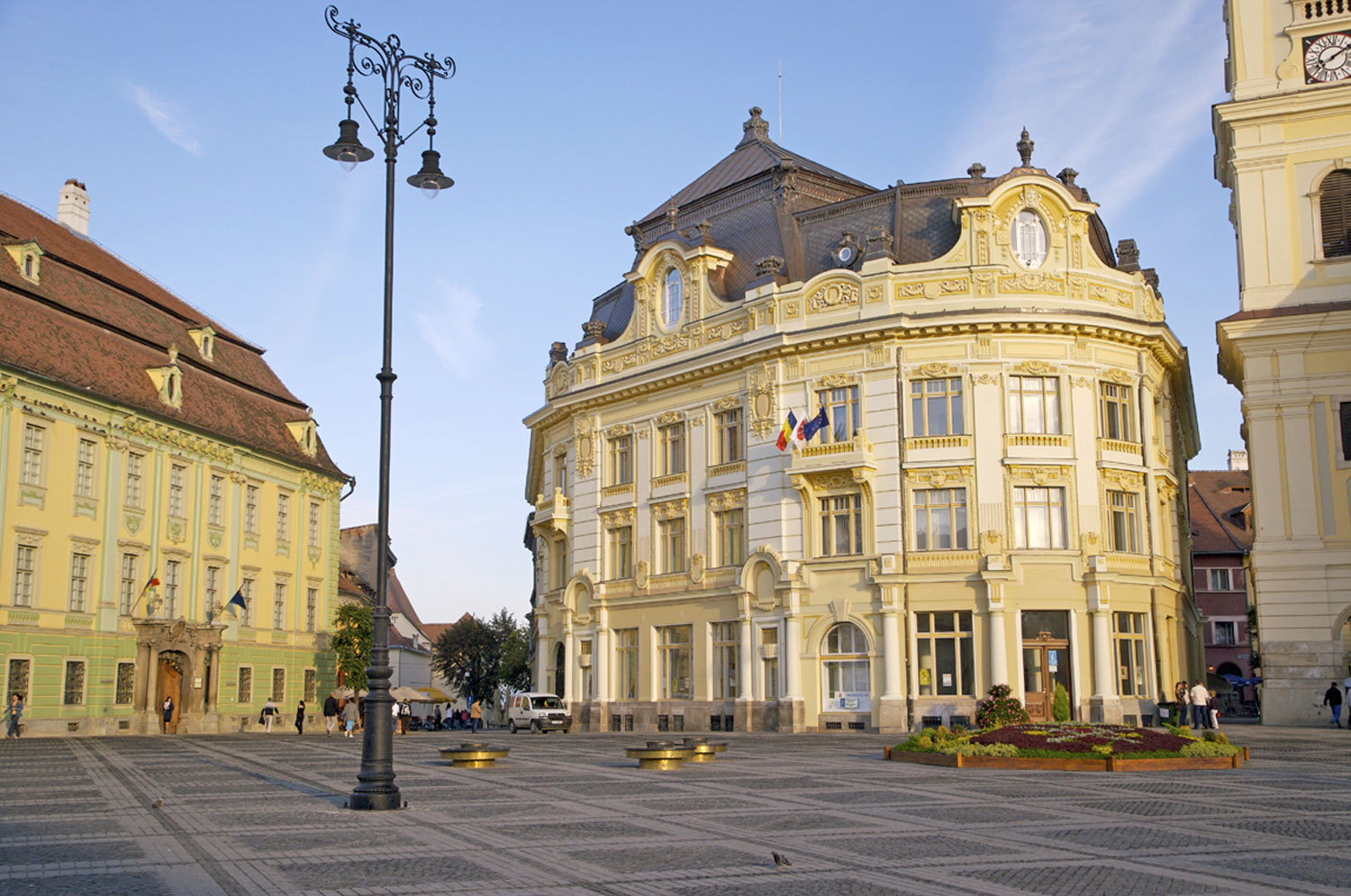
SIBIU TRIP PLANNING INFO
Sibiu Transportation
Sibiu is easily accessible from Bucharest (Bucuresti):
By plane (45 minutes),
By train (approximately 5 hours and 30 minutes) or
By car - via scenic routes over the Carpathians (approximately 4 hours and 30 minutes).
Sibiu International Airport - SBZ
Aeroportul International Sibiu
Address: Sos. Alba Iulia 73
Telephone: (+4) 0269 228.347
Sibiu airport is located 3.5 miles west of the city centre.
Bus # 11 (to downtown) stops 300 yards away from passenger terminal.
Map of bus #11 route and stops
(bus line 11 is shown in purple).
Taxi service to downtown also available.
Aproximate trip cost 30 Lei (RON) - approx $8.00.
Airlines with service to Sibiu include:
Air Connect, Austrian Airlines, Lufthansa, Tarom and Wizz Air.
...
Reaching Sibiu by TrainSibiu Train Station
Gara Sibiu
Address: Piata 1 Decembrie 1918 nr.6
(0.6 miles west of Old Town)
Tel: (+4) 0269 211.139
For the list of international trains with service to/from Romania please visit
RomaniaTourism International Transportation section.
There are direct, trains from Bucharest, Brasov and Timisoara to Sibiu
| Travel time with direct train to Sibiu from selected cities | |
|---|---|
| City of departure | Travel Time |
| Arad | 5:00 hours |
| Brasov | 2:40 hours |
| Bucharest | 5:45 hours |
| Budapest (Hungary) | 9:30 hours |
| Cluj Napoca (one connection) | 6:45 hours |
| Sighisoara | 2:30 hours |
| Sinaia | 4:15 hours |
To check train and bus schedules for domestic routes please visit
RomaniaTourism Domestic Transportation section
Sibiu SNCFR - Train tickets advance booking office
Sibiu Train Station
Address: Piața 1 Decembrie 1918 nr. 6
Tel: (+4) 0757 565,447
...
Inter-City Bus to/from SibiuSibiu Inter-City Bus Stations
Bus Companies offering transportation to Sibiu, from abroad:
Atlasib
Address: Autogara Turnisor
Tel: (+4) 0269 218.125
Daily bus service to Germany, Austria, Sweden, Italy, Spain, France
Double T
Address: Str. Nicolae Balcescu 1-3
Tel: (+4) 0269 217.497
Daily bus service to Germany, Austria, Italy, Switzerland
Eurolines
Address: Blvd. Vasile Milea 13A
Tel: (+4) 0269 212.248
Daily bus service to main cities around Europe
Pletl Agenture
Address: Calea Dumbravii 10
Tel: (+4) 0269 216.143
Daily bus service to Germany
Trans Europa
Address: Str. N. Balcescu 41
Tel: (+4) 0269 211 296
Daily bus service to Germany and Spain
Note: All TransEuropa buses leave Turnisor Bus Terminal A
Amad Touristik
Address: Calea Poplacii 58
Tel: (+4) 0269 212.227
Daily bus service to Italy, France, Spain and Portugal
Note: All Amad buses leave from bus terminal located at Calea Poplacii 56 - 58
...
Car travel to SibiuThe fastest route from Bucharest to Sibiu is via A1/E81:
Bucuresti – Pitesti – Ramnicu Valcea – Sibiu
The fastest route from Budapest to Sibiu is on E75 - E68:
Budapest- Szeged - Nadlac - Arad – Deva – Alba Iulia - Sibiu
| Road distance from Sibiu to: | |
|---|---|
| City | Distance |
| Bucharest | 170 miles |
| Arad | 165 miles |
| Belgrade (Serbia) | 275 miles |
| Brasov | 85 miles |
| Budapest (Hungary) | 360 miles |
| Cluj Napoca | 98 miles |
| Constanta | 290 miles |
| Iasi | 265 miles |
| Oradea | 195 miles |
| Satu Mare | 185 miles |
| Sighetu Marmatiei | 210 miles |
| Sighisoara | 55 miles |
| Suceava | 215 miles |
| Timisoara | 165 miles |
| Vienna | 530 miles |
29 bus routes
connect Sibiu’s neighborhoods and tourist attraction.
Tickets can be purchased in advance at ticket booths or onboard, using a contactless debit or credit card.
Bus # 1: Train station to Piata Unirii (city centre)
Bus # A5: Train station to Piata Unirii
Bus # 22:
Train station (Gara) to Paltinis (ski town)
Sibiu public transport routes map .
...
Rent a Bicycle in Sibiucompanies that are offering bicycle rental in Sibiu include:
Sibiu Bike City
Light Cycling
and
E-Bike Rentals
Sibiu Bicycle Itinerary Ideas:
1. Sibiu Old Town ( 2 miles )
Continental Forum Hotel - Great Square (Piata Mare)- Old Townhall (Primaria Veche)- Bruckenthal Museum -
Council Tower (Turnul Sfatului)- Little Square (Piata Mica)- Lies' Bridge (Podul Minciunilor) -
Arts and Crafts Home (Casa Artelor)- Huet Square (Piata Huet)
- Pasajul scarilor
2. Dumbrava Forest - ASTRA Museum (5 miles)
Sibiu Old Town - Dumbrava Forest (Padurea Dumbrava) - Sibiu Zoo (Gradina Zoologica)-
ASTRA Museum (Muzeul Civilizatiei Transilvane ASTRA)
3. Cisnadie (15 miles)
Sibiu - Cisnadie - Cisnadioara - Sibiu
4. Curmatura Strezii ( 22 miles )
Sibiu - Curmatura Stezii - Sibiu
5. Marginimea Sibiului ( 21 miles )
Sibiu - Rasinari - Gura Raului - Poplaca - Sibiu.
...
Sibiu TaxiTaxis are still relatively inexpensive and widely available.
Rates posted on passenger's front door are per kilometre.
| Taxi Company | Phone # |
|---|---|
| Taxi 924 | 0721 924.924 |
| Taxi 953 | 0735 539.953 |
| Taxi 942 | 0742 242.942 |
| Taxi Pronto | 0726 200.222 |
| Real Taxi | 0725 948.948 |
| Taxi Star | 0745 053.953 |
| Taxi Sibiu | 0757 774.077 |
...
Sibiu Car Rental
Great car rental rates in Sibiu.
Autonom
Tel: (+4) 0269 235.538
Enterprise – Touring Rent Auto
Sibiu Airport
Tel: (+4) 0722 375.392
EuroCars Romania
Sibiu Airport
Tel: (+4) 0727 373.799
Promotor Car Rental
Tel: (+4) 0743 403.403
Sixt
Tel: (+4) 021 94.00 (this is valid, short, phone #)
Swiso:
Sibiu Airport
Tel: (+4) 0786 191.361
...
Sibiu Hotels
Accommodations in Sibiu include:
| Hotel Name | Class | Location |
|---|---|---|
| Republique | boutique | Sibiu Old Town |
| Levoslav | boutique | Sibiu Old Town |
| Maison Elysée | boutique | Sibiu Old Town |
| Continental Forum | four-star / midscale | Sibiu City Centre |
| Ramada | four-star / midscale | Sibiu City Centre |
| Golden Tulip Ana Tower | four-star / midscale | Sibiu City Centre |
| Mercure Arsenal | four-star / midscale | 1.4 miles SW of Sibiu Old Town |
| Imparatul Romanilor | three-star / midscale | Sibiu Old Town |
| Continental | three-star / midscale | Sibiu City Centre |
| Hermanss | three-star / midscale | one mile east of Sibiu Old Town |
| Plaza 35 | three-star / midscale | 0.6 miles south of Sibiu City Centre |
...
Sibiu ShoppingNicolae Balcescu Street is the main commercial area where many shops, banks, coffee houses and restaurants are located.
Sibiu Handicrafts and Souvenir ShopsFlorile Transilvaniei
Strada Turnului 6
Telephone: (+4) 0735 547.788
Ie Românească
Strada Nicolae Bălcescu 9
Telephone: (+4) 0749 214.050
Deco Hobby Art
Calea Dumbrăvii 121B
Telephone: (+4) 0785 026.632
byRetroChique
Strada Alexandru Papiu-Ilarian
Telephone: (+4) 0733 383.538
Haine Rustice Artizanat
Strada Nicolae Bălcescu 9
Shopping City Sibiu
Strada Sibiului 5, Șelimbăr
Telephone: (+4) 0369 439.444
Promenada Mall
Strada Lector
Telephone: (+4) 021 232.13.98
Dumbrava Department Store
Piața Unirii 10
Telephone: (+4) 0741 322.848
Galeriile Comerciale Pacea
Strada Nicolae Bălcescu 29
Telephone: (+4) 0770 644.769
Fresh Produce Markets (Piața)
Discover local, authentic, foods and drinks by visiting Sibiu's fresh produce markets where farmers from the nearby villages sell fruits and vegetables, as well as local cheeses, fresh dairy and meat products:
Cibin Market
Piata Cibin
Open daily
The largest fruit and vegetable market in Sibiu is located at the NW end of Strada Turnului,
near Podul Cibin (Cibin Bridge).
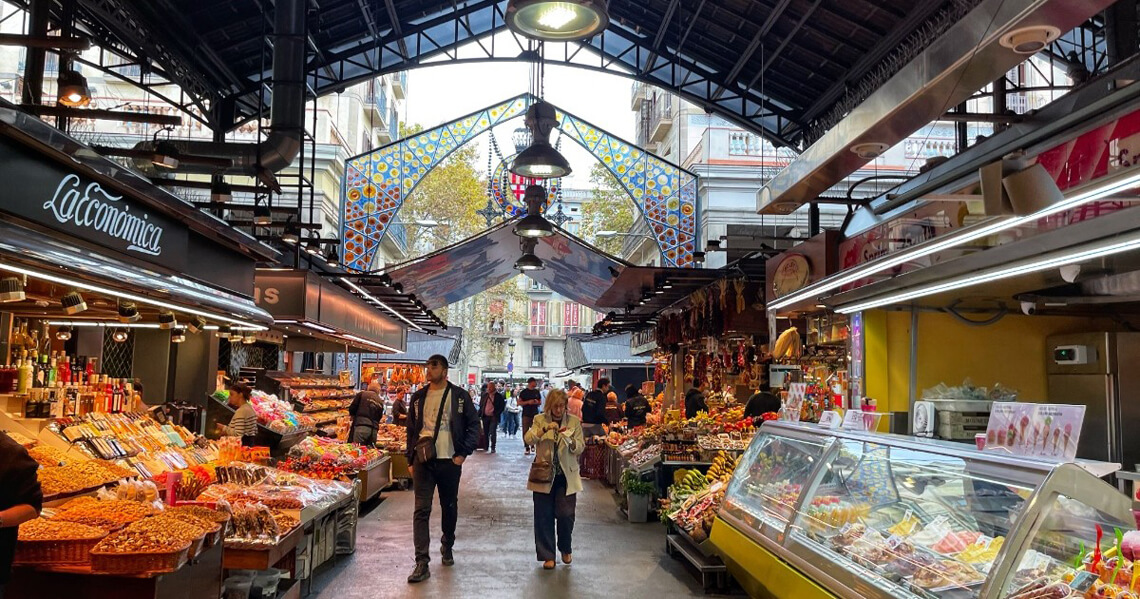
Rahovei Market
Piața Rahovei
Open: daily
Location: Strada Rahovei, near the SE end of Bulevardul Mihai Viteazul.
Vasile Aaron Market
Piața Vasile Aaron
Open: daily
Location: SE of the Old Town on Str. Semaforului.
Obor Flea Market
Targul Obor
Open: Tue., Fri. and Sun.
Numerous vendors offer a great range of goods that attract numerous locals and visitors.
Location: northern part of Sibiu at the intersection of Drumul Ocnei and Strada Oborul de Vite.
...
Sibiu Local Dishes
are based on cheese (several varieties), pork, lamb and grains
and represent the two main cultures in the area: Saxon and Romanian.
While in Sibiu you might want to try:
Hen Soup with Home-made Noodle (Supă de Găina cu Tăiţei)
Liver Dumpling Soup (Ciorbă cu găluşte de ficat)
Veal Sour Soup (Ciorbă Acră de Viţel)
(Pork) Meat Soup with Taragon (Ciorbă de Porc cu Tarhon)
Chicken Tarragon Meatball Stew - (Tocăniţa din Chiftele de Pui cu Tarhon)
Pork sirloin — Sibiu Style (Muschi de Porc Sibian)
Grilled, salt-curred, Mutton (Pastramă de Oaie)
Shepherd's Cheese Polenta (Bulz Ciobănesc)
Dressed Polenta - (Tapşe sau Mămăligă Dreasă)
Traditional Saxon Holiday Cake (Hencleş)
Sweet Noodles (Egg Noodles/similar to Fettuccine/, walnut and honey) - (Tăieţei cu Nucă)
Cottage Cheese Dumplings - (Papanaşi fierţi)
(Note: most restaurants in Romania serve fried dumplings,
the Papanaşi fierti, a Sibiu specialty, are boiled).
Sibiu restaurants worth trying:
| Restaurant Name | Cuisine | Location |
|---|---|---|
| Kulinarium | Local and International | Sibiu Old Town |
| Hermania | Local / Saxon | Sibiu Old Town |
| Hochmeister | Local / Saxon | Sibiu Old Town |
| Plai | Local | Sibiu Old Town |
| La Pasaj | Local and International | Sibiu Old Town |
| Kombinat | Local and International | Sibiu City Centre |
| Crama Sibiul Vechi | Local / Romanian | Sibiu Old Town |
Sibiu Local Beers:
Artisan beers produced in Sibiu include:
Bere Sibiu,
Augusta,
Urban,
Nembeer,
Bere Artizanala 1717.
...
Sibiu Tourist Info
Tourist Information Centre - Old Town Sibiu
Centrul de Informare Turistica
Address: Str. Samuel von Brukental 2
Tel: (+4) 0269 208.913
E-mail
Open:
Mon. - Fri.: 9 a.m. - 5 p.m.
Sat. - Sun.: 10 a.m. - 1 p.m.
ASTRA Museum Tourist Information Center
Centrul de Informare Muzeul ASTRA
Address: Str. Pădurea Dumbrava 16 - 20
Tel: (+4) 0756 085.795
E-mail
Open:
May -- September: 10 a.m. - 8 p.m., daily
October -- April: 9 a.m. - 5 p.m., daily
...
Sibiu Health and EmergencySibiu General Emergency phone#: 112
(Ambulance, Police, Fire Department)
Sibiu Pharmacies & Hospitals
Sibiu Pharmacies (Farmacie) open 24 hours:
Polisano Pharma
Bulevardul Mihai Viteazul 11
Telephone: (+4) 0269 421.418
SanMarco Alphega
Strada Nicolae Iorga 52
Telephone: (+4) 0269 232.187
Eco Farmacia
Bloc 20, Strada Constituției 23
Telephone: (+4) 0269 233.683
Hospitals in Sibiu
Emergency Clinic Hospital
Spitalul Clinic Judetean Sibiu
Address: Bd.Corneliu Coposu 2-4
Tel: (+4) 0269 215.050
Emergency Military Hospital
Spitalul Militar de Urgenta
Address: Bulevardul Victoriei 46
Tel: (+4) 0269 211.209
Sibiu Children's Hospital
Spitalul Clinic de Pediatrie Sibiu
Address: Strada George Barițiu 3
Tel: (+4) 0269 217.810
...
Sibiu Local Authorities
Sibiu City Hall
Primaria Municipiului Sibiu
Address: Str. Samuel Brukenthal 2 / Piata Mica 23
Tel: (+4) 0269 208.800
Sibiu County Archives
Directia Judeteana Sibiu a Arhivelor Nationale
Address: Str. Arhivelor 3 Sibiu, postal code 550164
Tel: (+4) 0269 208.519
E-mail
Hours
Bureau of Consumer Protection
Comisariatul Judetean pentru Protectia Consumatorilor - Sibiu (ANPC)
Address: Str. Dorului 21
Tel: (+4) 0269 234.458
Sibiu Police Department
Inspectoratul de Politie Judetean Sibiu
Tel: (+4) 0269 208.800
Sibiu Main Post Office
Oficiul Postal Sibiu
Address: Str. Mitropoliei 14
Tel: (+4) 0269 323.179
Open: Mon. – Fri.: 7 a.m. – 8 p.m. Sat.: 8 a.m. – 1 p.m.
Post offices display a postal horn symbol and the word Posta.
Telephoning Sibiu from Abroad
International Access Code +4 (Romania country code) + 0269 or 0369 (area code) + six-digit telephone number.
...
Sibiu Maps
Sibiu City Map - Harta Orasului Sibiu
Sibiu Interactive Map - Harta Interactiva a Municipiului Sibiu
Romania Tourist Attractions Map - Harta Atractii Turistice Romania


